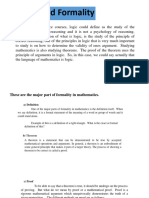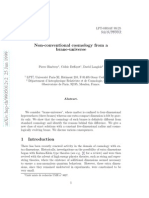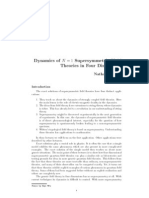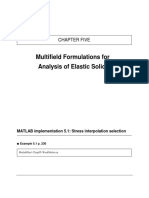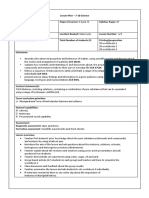Axiom of Parallelism in Euclidean Geometry Is One Such Example
Axiom of Parallelism in Euclidean Geometry Is One Such Example
Uploaded by
JACopyright:
Available Formats
Axiom of Parallelism in Euclidean Geometry Is One Such Example
Axiom of Parallelism in Euclidean Geometry Is One Such Example
Uploaded by
JAOriginal Title
Copyright
Available Formats
Share this document
Did you find this document useful?
Is this content inappropriate?
Copyright:
Available Formats
Axiom of Parallelism in Euclidean Geometry Is One Such Example
Axiom of Parallelism in Euclidean Geometry Is One Such Example
Uploaded by
JACopyright:
Available Formats
Theorem — a mathematical statement that is proved using rigorous mathematical reasoning.
In
a mathematical paper, the term theorem is often reserved for the most important results or a
major result. Examples are: 1.Every manifold has a simply connected covering space.
2. An inscribed angle a° is half of the central angle 2a° Called the Angle at the Center Theorem.
3. Another example for you, related to Pythagoras' Theorem. If m and n are any two whole
numbers and
a = m2 − n2
b = 2mn
c = m2 + n2
then a2 + b2 = c2
Corollary — a result in which the (usually short) proof relies heavily on a given theorem (we
often say that “this is a corollary of Theorem A”) or is a theorem that follows on from another
theorem. Example: 1. A consequence to the Hopf-Rinow theorem is that compact manifolds are
geodesically complete.
2. (This is called the "Angles Subtended by the Same Arc Theorem", but it’s really just a
Corollary of the "Angle at the Center Theorem").
Keeping the endpoints fixed ... ... the angle a° is always the same, no matter where it is on the
circumference. So, Angles Subtended by the Same Arc are equal.
3. a, b and c, as defined in Pythagorean theorem., are a Pythagorean Triple. From the Theorem a2
+ b2 = c2, so a, b and c are a Pythagorean Triple.
Axiom/Postulate — a statement that is assumed to be true without proof. These are the basic
building blocks from which all theorems are proved. An example from the Euclidean geometry,
let us consider the Pythagoras’ theorem. While providing supportive statements to the arguments
we make to prove this theorem, we make use of the “axioms”. axiom of parallelism in Euclidean
geometry is one such example
(Euclid’s five postulates, Zermelo-Fraenkel axioms, Peano axioms).
Axioms are used as building blocks or foundations to prove a certain statement, which is called a
“theorem”.
In mathematics, the term axiom is used in two related but distinguishable senses: "logical
axioms" and "non-logical axioms".
Logical axioms are usually statements that are taken to be true within the system of logic they
define (e.g., (A and B) implies A), while non-logical axioms (e.g., a + b = b + a) are actually
defining properties for the domain of a specific mathematical theory (such as arithmetic).
"It is possible to extend a line segment continuously in both directions." another example is- "It
is true that all right angles are equal to one another".
Lemma — a minor result whose sole purpose is to help in proving a theorem. It is a stepping
stone on the path to proving a theorem. It is generally used to describe facts that are used in the
proof of a more significant result or the small results (less important than a theorem).
Examples are:1. (This is sometimes called the "Angle in the Semicircle Theorem", but it’s really
just a Lemma to the "Angle at the Center Theorem"). In the special case where the central angle
forms a diameter of the circle. So an angle inscribed in a semicircle is always a right angle.
2. If m = 2 and n = 1, then we get the Pythagorean triple 3, 4 and 5
Proof:
If m = 2 and n = 1, then
a = 22 − 12 = 4 − 1 = 3
b=2×2×1=4
c = 22 + 12 = 4 + 1 = 5
Very occasionally lemmas can take on a life of their own (Zorn’s lemma, Urysohn’s lemma,
Burnside’s lemma, Sperner’s lemma).
Conjecture — a statement that is unproved, but is believed to be true (Collatz conjecture,
Goldbach conjecture, twin prime conjecture).
Conjecture-It is a conclusion which appears to be correct based on incomplete information, but
for which no proof has been found.
Such as Riemann hypothesis which states that that the non-trivial zeros of the Riemann zeta
function all have real part 1/2. Example: The Poincare´e´ conjecture was a famous statement that
remained an open research problem in topology for roughly a century. The claim was that every
simply connected, compact 3-manifold was homeomorphic to the 3-sphere S3S3. This statement
however is no longer a conjecture since it was famously proven by Grigori Perelman in 2003.
Significant results are frequently called theorems.
Short, easy results of theorems are called corollaries.
But the words aren't exactly that set in stone.
A lemma are those minor results which are used into proving a definite results of a theorem.
Relationship
You cannot have a theorem without at least two axioms, and you cannot
have a corollary without (one) theorem. And a theorem could be seen as a
postulate that has grown up into the the full article.
Lemmas are smaller results to be used in a bigger (more important) result and lemma is also just
as true as a theorem. The big result is usually a theorem. Corollaries are special cases of
theorems and the easy results of theorems. Many important theorems were once conjectures.
generally accepted to be true. But when a conjecture has been proven, it
is no longer a conjecture but a "theorem".
You might also like
- Diophantine EquationDocument6 pagesDiophantine EquationHazel Clemente CarreonNo ratings yet
- Harcourt - Geometry and Discrete 12Document561 pagesHarcourt - Geometry and Discrete 12Uwo Turnt100% (1)
- Reading Program Programs in The PhilippinesDocument31 pagesReading Program Programs in The PhilippinesJA100% (8)
- Infinite Sums, Diophantine Equations and Fermat's Last TheoremDocument23 pagesInfinite Sums, Diophantine Equations and Fermat's Last Theoremcharlotteyu15No ratings yet
- AxiomDocument2 pagesAxiomJeamea EyanoNo ratings yet
- ThcorlemDocument1 pageThcorlemswpitaraNo ratings yet
- The Mathematics of Fermat's Last TheoremDocument39 pagesThe Mathematics of Fermat's Last TheoremManole BuicanNo ratings yet
- MAT198 Session 7Document13 pagesMAT198 Session 7Sweetie Marie MonteroNo ratings yet
- School of Mathematical Sciences MAT 3044 Discrete MathematicsDocument20 pagesSchool of Mathematical Sciences MAT 3044 Discrete MathematicsThalika RuchaiaNo ratings yet
- Advanced Calculus LecturesDocument216 pagesAdvanced Calculus LecturesGabriel Vasconcelos100% (1)
- What Is MathematicsDocument6 pagesWhat Is MathematicsYared BitewNo ratings yet
- Symm in PH LimDocument103 pagesSymm in PH LimOmar QuirozNo ratings yet
- BealconjDocument31 pagesBealconjAlekseyevich GagarinNo ratings yet
- An Axiomatic Basis of Space-Time Theory. Part I Construction of A Casual Space With Coordinates by Joachim SchröterDocument31 pagesAn Axiomatic Basis of Space-Time Theory. Part I Construction of A Casual Space With Coordinates by Joachim SchröterTomás CampoNo ratings yet
- The Fundamental Theorem of Algebra and Complexity Theory: by Steve SmaleDocument36 pagesThe Fundamental Theorem of Algebra and Complexity Theory: by Steve SmaleshekhawatmahaveerNo ratings yet
- Corregido Artiulo William PorrasDocument9 pagesCorregido Artiulo William PorrasPedro Pablo Ortega PalenciaNo ratings yet
- BrownDocument36 pagesBrownfarsamuels183No ratings yet
- MMW 3Document11 pagesMMW 3Ribbo HelliuNo ratings yet
- Introduction To Proof: Chapter ExpectationsDocument483 pagesIntroduction To Proof: Chapter ExpectationsNimisha Anant100% (1)
- Paper PDFDocument167 pagesPaper PDFPablo andres7123No ratings yet
- 0 - IntroductionDocument8 pages0 - IntroductionIvanhoe BalaroteNo ratings yet
- A Self-Instructional Module On Mathematics in The Modern WorldDocument29 pagesA Self-Instructional Module On Mathematics in The Modern WorldGeorge Vincent SismarNo ratings yet
- Giga M. Basic Guide To Uniqueness Problems For Evolutionary Diff. Equ. 2023Document163 pagesGiga M. Basic Guide To Uniqueness Problems For Evolutionary Diff. Equ. 2023MUHAMMAD ARIFNo ratings yet
- Fermats Last Theorem - ThesisDocument21 pagesFermats Last Theorem - Thesisarun rajaramNo ratings yet
- Normal Forms and Lie Groupoid TheoryDocument18 pagesNormal Forms and Lie Groupoid TheoryJohn BirdNo ratings yet
- A Guide To The Foundations of LogicDocument7 pagesA Guide To The Foundations of LogicsemenchumnoyNo ratings yet
- Symmetry in Physics Lecturer: Dr. Eugene A. Lim 2012-2013 Year 2 Semester 2 Theoretical Physics Office : S7.32 King’s College London http://www.damtp.cam.ac.uk/user/eal40/teach/symmetry2013/symroot.htmlDocument76 pagesSymmetry in Physics Lecturer: Dr. Eugene A. Lim 2012-2013 Year 2 Semester 2 Theoretical Physics Office : S7.32 King’s College London http://www.damtp.cam.ac.uk/user/eal40/teach/symmetry2013/symroot.htmlmarkrichardmuradNo ratings yet
- Algebraic LogicDocument43 pagesAlgebraic LogicRodrigo Ferreira100% (2)
- Mathematical ProofsDocument11 pagesMathematical Proofssith_tigerNo ratings yet
- Approximation: Certainty SeriesDocument4 pagesApproximation: Certainty SeriesLakshmiPriyaNo ratings yet
- Susy1996 CornellDocument190 pagesSusy1996 CornellRoy VeseyNo ratings yet
- Susy1996 PDFDocument190 pagesSusy1996 PDFPero PericNo ratings yet
- Perturbation TheoryDocument6 pagesPerturbation TheoryAtikshaNo ratings yet
- Pierre Binetruy, Cedric Deffayet and David Langlois - Non-Conventional Cosmology From A Brane-UniverseDocument22 pagesPierre Binetruy, Cedric Deffayet and David Langlois - Non-Conventional Cosmology From A Brane-UniverseHuntsmithNo ratings yet
- Advanced Particle Physics - Lecture 1 Overview, Units and Notation 1Document3 pagesAdvanced Particle Physics - Lecture 1 Overview, Units and Notation 1epidermNo ratings yet
- AMSI 2upDocument40 pagesAMSI 2upFatih TokgözNo ratings yet
- Algebra and Number TheoryDocument35 pagesAlgebra and Number TheoryNeo Dacutanan Yabis100% (1)
- Dan Kalman - An Elementary Proof of Marden's TheoremDocument9 pagesDan Kalman - An Elementary Proof of Marden's TheoremnativadeperuNo ratings yet
- SUSYLectures ConlonDocument75 pagesSUSYLectures Conlonlibrero80No ratings yet
- The Story of Fermat's Last Theorem (Akanksha)Document10 pagesThe Story of Fermat's Last Theorem (Akanksha)Akanksha MehraNo ratings yet
- Applications of Number Theory To Fermat's Last Theorem: Cameron Byerley May 14, 2006Document27 pagesApplications of Number Theory To Fermat's Last Theorem: Cameron Byerley May 14, 2006RishiNo ratings yet
- Definition of Subset: 1. LogicDocument2 pagesDefinition of Subset: 1. LogicAngelie Conel DizonNo ratings yet
- Brown 1950Document4 pagesBrown 1950liz.rc.3054No ratings yet
- Notes Real AnalysisDocument91 pagesNotes Real AnalysisCarlos MartinezNo ratings yet
- LV Jindong 3C The Lagrangian Method and The Hamiltonian Method Physics Portfolio Work 5Document14 pagesLV Jindong 3C The Lagrangian Method and The Hamiltonian Method Physics Portfolio Work 5LVFirestormNo ratings yet
- Mean Value TheoremsDocument40 pagesMean Value TheoremsNaziya parween50% (2)
- Square Root of 2Document12 pagesSquare Root of 2davierangNo ratings yet
- Dimension Functions: Depth, Measuring Singularities: Pieter Belmans February 14, 2014Document11 pagesDimension Functions: Depth, Measuring Singularities: Pieter Belmans February 14, 2014Toto de DauphineNo ratings yet
- Goren NotesDocument123 pagesGoren NotesRohailTariqNo ratings yet
- Andre Wiles El Teorema de Fermat y Langlands 1712511776Document8 pagesAndre Wiles El Teorema de Fermat y Langlands 1712511776Carlos CañizaresNo ratings yet
- Dynamics of Supersymmetric Field Theories in Four DimensionsDocument35 pagesDynamics of Supersymmetric Field Theories in Four DimensionsluisdanielNo ratings yet
- Module 2 - 5 Logic and FormalityDocument20 pagesModule 2 - 5 Logic and FormalityraydieuxxNo ratings yet
- Introduction To Fractional Calculus Amna Al - Amri Project October 2010Document29 pagesIntroduction To Fractional Calculus Amna Al - Amri Project October 2010karamaniNo ratings yet
- Logic and FormalityDocument18 pagesLogic and FormalityFLORELY LUNANo ratings yet
- Compact Sets and Continuous FunctionsDocument5 pagesCompact Sets and Continuous FunctionsMohammad Reza MusaviNo ratings yet
- Chapter 1 - IntroductionDocument13 pagesChapter 1 - IntroductionNajat AlbarakatiNo ratings yet
- Logical Reasoning NotesDocument60 pagesLogical Reasoning NotesGyaani GuptaNo ratings yet
- Neutral Geometry and The Independence of The Parallel PostulateDocument14 pagesNeutral Geometry and The Independence of The Parallel PostulateWeston MuniakNo ratings yet
- Poor Reading ComprehensionDocument7 pagesPoor Reading ComprehensionJANo ratings yet
- Issues On Reading: Psychological Problems Social Problems Physical ProblemsDocument8 pagesIssues On Reading: Psychological Problems Social Problems Physical ProblemsJANo ratings yet
- (TOR) Issues and Programs On ReadingDocument10 pages(TOR) Issues and Programs On ReadingJANo ratings yet
- Reflection Paper ASEAN Socio-CulturalDocument1 pageReflection Paper ASEAN Socio-CulturalJANo ratings yet
- General Principles of Social Learning Theory: - Attention - Retention - Motor ReproductionDocument3 pagesGeneral Principles of Social Learning Theory: - Attention - Retention - Motor ReproductionJANo ratings yet
- Learning Style Exploration For Strong Educational FoundationDocument2 pagesLearning Style Exploration For Strong Educational FoundationJANo ratings yet
- Concepts of LearningDocument16 pagesConcepts of LearningJANo ratings yet
- Chapter 6: Business Strategy: Differentiation, Cost Leadership, and Blue OceansDocument4 pagesChapter 6: Business Strategy: Differentiation, Cost Leadership, and Blue OceansJANo ratings yet
- CHAPTER 7 StramaDocument4 pagesCHAPTER 7 StramaJANo ratings yet
- Midterm Exam Subject: Economic Statistics (INS2004) : Prob 1Document2 pagesMidterm Exam Subject: Economic Statistics (INS2004) : Prob 1Trần HàNo ratings yet
- As Biology Unit 2 Key Terms and DefinitionsDocument6 pagesAs Biology Unit 2 Key Terms and DefinitionsVIctoriakayNo ratings yet
- Aace18r 97Document11 pagesAace18r 97Mario WiryaNo ratings yet
- Multifield Formulations For Analysis of Elastic Solids: Chapter FiveDocument32 pagesMultifield Formulations For Analysis of Elastic Solids: Chapter FiveWeight lossNo ratings yet
- Curriculum 1a-Assessment 1Document4 pagesCurriculum 1a-Assessment 1api-522285700No ratings yet
- Irrawaddy Delta ImprovementDocument47 pagesIrrawaddy Delta Improvementwin Zaw TheinNo ratings yet
- DPM 4207 - Turk - Assgn - 1 - Joseph Et GradedDocument4 pagesDPM 4207 - Turk - Assgn - 1 - Joseph Et Gradedkizzy McraeNo ratings yet
- Aldersgate College Technology For Teaching and Learning 1 College of Arts, Sciences and Education Junelyn G. Villar, LPTDocument3 pagesAldersgate College Technology For Teaching and Learning 1 College of Arts, Sciences and Education Junelyn G. Villar, LPTJunelyn Gapuz VillarNo ratings yet
- CSDocument21 pagesCSDev ShahNo ratings yet
- Lesson 3. Writing Task 1 - Static ChartDocument7 pagesLesson 3. Writing Task 1 - Static Chartearthplanet1505No ratings yet
- Chapter 3 Importance of MotivationDocument6 pagesChapter 3 Importance of MotivationLovenia M. FerrerNo ratings yet
- Module Iii - Materials Quality Conrol: Engr. Jehela G. RoxasDocument34 pagesModule Iii - Materials Quality Conrol: Engr. Jehela G. RoxasEvaresto Cole MalonesNo ratings yet
- Progress Report Thannuss CheckedDocument20 pagesProgress Report Thannuss CheckedKT CRUNCHES STUDIOSNo ratings yet
- Seventh ScheduleDocument20 pagesSeventh ScheduleQuality JiveNo ratings yet
- Childcare Resume 1Document2 pagesChildcare Resume 1api-704123206No ratings yet
- Final Guideline & Toolkit For Access and Benefit Sharing of aTK in Rwanda FINALDocument48 pagesFinal Guideline & Toolkit For Access and Benefit Sharing of aTK in Rwanda FINALErmiyas YeshitlaNo ratings yet
- The Analysis of Wastewater Treatment System Efficiencies in Kenya: A Review PaperDocument12 pagesThe Analysis of Wastewater Treatment System Efficiencies in Kenya: A Review PaperFLORY Kilingo MkangombeNo ratings yet
- Methods of Geological Engineering in Discontinous RocksDocument484 pagesMethods of Geological Engineering in Discontinous RocksricardoNo ratings yet
- CE Review Advanced MathematicsDocument2 pagesCE Review Advanced MathematicsRAYNo ratings yet
- PT-4 Social Agents and How They Impact UsDocument1 pagePT-4 Social Agents and How They Impact UsLuis JoseNo ratings yet
- Advertisement EstDocument1 pageAdvertisement Estjamil ahmedNo ratings yet
- GalaksijaDocument4 pagesGalaksijaISHAK BULJUBASICNo ratings yet
- EGRA Waray Grade 3Document16 pagesEGRA Waray Grade 3EmmaNo ratings yet
- Chapter 11: Radiation - 11.1.3 Magnetic Dipole Radiation (Not Complete)Document2 pagesChapter 11: Radiation - 11.1.3 Magnetic Dipole Radiation (Not Complete)Nirav PatelNo ratings yet
- UU Test ReportDocument4 pagesUU Test ReportSharunieRavikumar33% (3)
- 核磁图像导航的注射机器人系统关键技术研究 张莹Document86 pages核磁图像导航的注射机器人系统关键技术研究 张莹峰王No ratings yet
- Boyce ODEch 7 S 3 P 22Document4 pagesBoyce ODEch 7 S 3 P 22Severus SnapeNo ratings yet
- Narrative 236k TreesDocument1 pageNarrative 236k TreesDinah r. De guzmanNo ratings yet
- Baupanel Application Standard Seismic-Resistant ConstructionDocument11 pagesBaupanel Application Standard Seismic-Resistant Constructionİhsan TazeNo ratings yet
- Internship Report OGDCLDocument61 pagesInternship Report OGDCLsyed Muntazir naqvi91% (11)


















